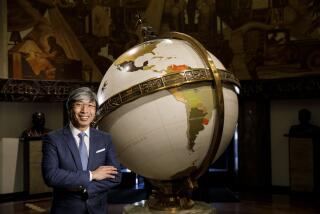A doctor without borders
- Share via
The gig: Billionaire chairman of drug developer Abraxis BioScience Inc. and philanthropist.
Age: 57
Family: Wife Michele Chan and two children
Home: West Los Angeles
Hobbies: Boogie boarding and basketball
How it all started: The son of a Chinese practitioner of traditional medicine, Soon-Shiong (pronounced soon-shong)grew up in apartheid South Africa. He earned his medical degree in Johannesburg and joined UCLA as a surgeon and medical professor at age 31.
His fortune is tied to his stake in Abraxis BioScience, a Los Angeles drug development company formed from two firms he founded to pursue promising therapies for cancer, diabetes and other devastating diseases. Abraxis is best known for its blockbuster drug Abraxane, a cancer treatment Soon-Shiong helped develop.
Life mission: To shrink what he calls the “valley of death” -- the time between the discovery of a drug or medical technology and its practical application for patients -- as well as the gap between rich and poor in health and healthcare. He encountered both problems as a young physician in South Africa.
New challenges: Now, with a net worth estimated by Forbes magazine at $5.5 billion he made as a medical entrepreneur, Soon-Shiong has embarked on a new phase of his life: philanthropy.
Through the Chan Soon-Shiong Family Foundation, he and his wife, Michele Chan, are spurring efforts to bridge the gap between science and medicine and to erase the disparities in healthcare between the rich and the poor.
Those efforts began with a $135-million gift to renovate
St. John’s Health Center in Santa Monica and to set up a center that brings together top physicians and research scientists to treat acutely ill patients. And they continue. Last month, Soon-Shiong announced plans to provide University of California regents with a $100-million guarantee to underwrite efforts by Los Angeles County to reopen Martin Luther King Jr. Hospital.
You wear many hats -- research scientist, medical entrepreneur, philanthropist and father, to name a few. How do you see yourself?
I see it all as a continuous pursuit of finding better care for patients. If you look at all the things I’m doing, the single thread is driving science for the better care of patients. . . . It’s all driving towards how can we get better technology for patients and how can it help people not just in the United States but around the globe.
How did South Africa shape your outlook?
It was a searing part of my life. I was treating these teenagers as they were being shot during the Soweto riots. And when I finished my internship as the first Chinese in a white hospital in South Africa, I went to work in TB clinics and felt pretty helpless without any access to any technology including X-ray machines. That drove a lot of what I do today.
You also are working onsomething you call a medical information highway. What’s that all about?
We are creating a computer grid. It will allow patients or doctors to get on and exchange medical information so the doctors and patients could know and be aware of the most up-to-date treatments for patients to create the best outcomes.
My concern is that the science of molecular medicine is evolving so rapidly that doctors can’t keep up, and the only way for them to have decision support is for them to have access to information in real time. And they need to have that information at the point of care. We need to have this medical information highway.
What prompted your interest in Martin Luther King Jr. Hospital?
When I learned that a patient died in the emergency room calling 911, I actually walked into the emergency room one weekend to find out what happened. What happened was a lack of leadership and accountability. It wasn’t a lack of money. The county poured a lot of money into that place. There was a need to drive excellence down there.
The UC Board of Regents voted unanimously Thursday to reopen MLK Hospital after you threw your support behind it. That must have felt good.
This vote was historic. This actually can truly serve as a model for the nation as we transform healthcare. We will be able to take the underserved and the uninsured population involving almost a million people in downtown Los Angeles and bring together the best of academia through the University of California system, but also the county, state and federal government, and bring in philanthropy, the private sector.
How do you decide what philanthropic endeavors to pursue?
I come from a physician’s perspective. I happen to be a scientist, and I am very blessed with the resources to take advantage of that skill set. Because I come from South Africa, I see how the underdog and the discriminated and the people without insurance affect not only a generation but an entire nation. . . . We want to bring the next generation of technology to people with no care and bring it very rapidly to people who are underserved. That really is the sweet spot.
What’s the key to your success?
I think how I made it is being true to the vision of following the cause of developing technologies that will really have meaningful change for patients.
You head up a couple of research institutes at UCLA and you are involved in USC’s engineering school. Which team do you root for?
I am Switzerland in Los Angeles. I go with the USC football team, and I go with the UCLA basketball team.
More to Read
Inside the business of entertainment
The Wide Shot brings you news, analysis and insights on everything from streaming wars to production — and what it all means for the future.
You may occasionally receive promotional content from the Los Angeles Times.











